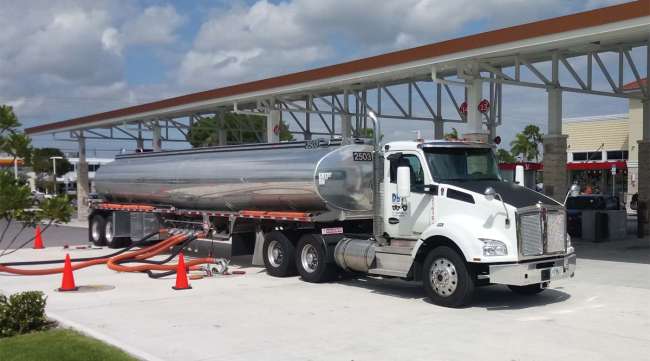Senior Reporter
National Average Price of Diesel Sheds 1.3¢ in Second Consecutive Decline

[Stay on top of transportation news: Get TTNews in your inbox.]
The national average price of diesel dropped 1.3 cents a gallon to $2.422, the Energy Information Administration reported Sept. 14. Diesel costs 56.5 cents a gallon less than it did a year ago after the second straight weekly drop.
The average price for trucking’s main fuel fell in all 10 regions in EIA’s survey.
Meanwhile, the national average price of a gallon of gasoline fell 2.8 cents a gallon to $2.183.
The Central Atlantic, Lower Atlantic and Midwest saw the deepest drop in diesel price at 1.3 cents per gallon. In the Central Atlantic region, the price dropped to $2.676. There, diesel is 50.1 cents less expensive than a year ago.

What are fleets doing to help attract the best possible diesel technicians to join the changing workforce environment? Host Michael Freeze speaks with Ken Boyer, dean of the Auto/Diesel Institute at Baker College, and Ralph Romero, vice president of talent management at U.S. Xpress. Hear a snippet, above, and get the full program by going to RoadSigns.TTNews.com.
In the Lower Atlantic, a gallon now costs $2.357, and diesel sells for 51.7 cents less than it did at this time a year ago.
Diesel in the Midwest now costs $2.308, and it is 57.4 cents less per gallon than one year ago.
The smallest drop was in New England, where the price dipped seven-tenths of a cent to $2.605. Diesel there is 40.8 cents less expensive than at this time in 2019.
The most expensive diesel remains in California, where the price declined nine-tenths of a cent to $3.267 a gallon. The fuel there is 63.4 cents a gallon less expensive than a year ago.
Diesel along the Gulf Coast remains the least expensive, sliding 1.2 cents to $2.172. In that region, the cost is 58.9 cents cheaper than last year.
The Gulf Coast boasts the lowest price for gasoline and oil in part because it is home to much of the country’s oil and gasoline production and a large share of the refining capacity. However, that region again is facing the threat of damage from severe weather: Hurricane Sally, a Category 2 storm, may have missed the refineries when it took an easterly turn and came ashore near the Alabama-Florida border.

A boat is washed up near a road after Hurricane Sally moved through the area Sept. 16, 2020, in Orange Beach, Ala. (Gerald Herbert/Associated Press)
Still, for the second time in less than a month, oil industry employees who work in the region had to evacuate. Sally temporarily shut down 27.5% of all oil production and 29.7% of all natural gas production in the Gulf. That’s 508,366 barrels of oil production and 805 million cubic feet per day of natural gas production, according to the Department of the Interior. The federal government said workers had returned to shore from 147 production platforms, which represent 23% of the 643 platforms that operate in the Gulf. But that oil and gas production shutdown is 65% less extensive than when Hurricane Laura came ashore further west in Louisiana and struck some of the nation’s refining capacity.
The Interior Department said Sept. 16 that because Sally came ashore farther east than anticipated, some oil and chemical facilities along the Mississippi River and the deep-water oil export terminal, the Louisiana Offshore Oil Port, reopened. And some of the oil and gas workers who had been evacuated were being allowed to return to their offshore platforms.
At press time, Sally had weakened to a tropical storm, but it was pounding the Pensacola, Fla., area, and other parts of Florida and Alabama were submerged by flooding. Numerous rivers were approaching dangerous levels, and several counties were under curfews to keep residents safe.

Vehicles are underwater on a Pensacola, Fla., street Sept. 16, 2020. (Gerald Herbert/Associated Press)
According to the National Hurricane Center, Sally dumped up to 30 inches of rain from the Florida Panhandle to Mobile Bay, Ala., leading to “historic and catastrophic flooding” there and threatening even more communities as it moved north.
Meanwhile, West Texas Intermediate Crude, the industry’s benchmark fuel, briefly moved above $40 a barrel Sept. 16, reaching $40.11.
It is the first time in nearly two weeks that WTI has breached the $40-per-barrel mark. Still, one year ago, WTI was trading at $62.90.
Earlier in the week, WTI fell to $37.26 a gallon on the New York Mercantile Exchange on Sept. 14. The drop in price was attributed to a lack of demand for diesel and gasoline now that the summer driving season is over.
Also, millions of Americans still are working from home because of the COVID-19 pandemic and have substantially cut down on daily driving.
The number of oil rigs operating in the U.S. slipped by two to 254, according to the weekly Baker Hughes count for the week ending Sept. 11. A year ago, 886 rigs were in operation. In Canada, the number remained flat at 52, but that represents 82 fewer than the 134 operating in 2019.
Want more news? Listen to today's daily briefing:
Subscribe: Apple Podcasts | Spotify | Amazon Alexa | Google Assistant | More




